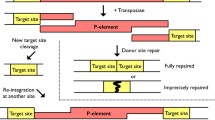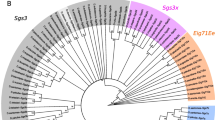Abstract
To examine whether structural and functional differences exist in the proliferation disrupter (prod) genes between Drosophila simulans and D. melanogaster, we analyzed and compared both genes. The exon–intron structure of the genes was found to be the same – three exons were interrupted by two introns, although a previous report suggested that only one intron existed in D. melanogaster. The prod genes of D. simulans and D. melanogaster both turn out to encode 346 amino acids, not 301 as previously reported for D. melanogaster. The numbers of nucleotide substitutions in the prod genes was 0.0747 ± per synonymous site and 0.0116 ± 0.0039 per replacement site, both comparable to those previously known for homologous genes between D. simulans and D. melanogaster. Genetic analysis demonstrated that D. simulans PROD can compensate for a deficiency of D. melanogaster PROD in hybrids. The PRODs of D. simulans and D. melanogaster presumably share the same function and a conserved working mechanism. The prod gene showed no significant interaction with the lethality of the male hybrid between these species.
Similar content being viewed by others
References
Csink, A.K. & S. Henikoff, 1998. Something from nothing: the evolution and utility of satellite repeats. Trends Genetics 14: 200–204.
Hawkins, J.D., 1988. A survey on intron and exon lengths. Nucleic Acids Res. 16: 9893–9908.
Ina, Y., 1995. New methods for estimating the numbers of synonymous and nonsynonymous substitutions. J. Mol. Evol. 40: 190–226.
Itoh, M., M.-T. Yamamoto & T.K. Watanabe, 1997. Molecular cloning of prod gene of Drosophila simulans. Genes Genet. Syst. 72: 391.
Kimura, M., 1980. A simple method for estimating evolutionary rates of base substitutions through comparative studies of nucleotide sequences. J. Mol. Evol. 16: 111–120.
Moriyama, E.N. & J.R. Powell, 1996. Intraspecific nuclear DNA variation in Drosophila. Mol. Biol. Evol. 13: 261–277.
Mount, S.M., 1982. A catalogue of splice junction sequences. Nucl. Acid Res. 10: 459–472.
Orr, H.A., L.D. Madden, J.A. Coyne, R. Goodwin & R.S. Hawley, 1997. The developmental genetics of hybrid inviability: a mitotic defect in Drosophila hybrids. Genetics 145: 1031–1040.
Platero, J.S., A.K. Csink, A. Quintanilla & S. Henikoff, 1998. Changes in chromosomal localization of heterochromatin-binding proteins during the cell cycle in Drosophila. J. Cell Bio. 140: 1297–1306.
Sambrook, J., E.F. Frisch & T. Maniatis, 1989. Molecular Cloning: A Laboratory Manual, 2nd edn. Cold Spring Harbor Laboratory, Cold Spring Harbor, NY.
Sanger, F., S. Nicklen & A.R. Coulson, 1977. DNA sequencing with chain-terminating inhibitors. Proc. Natl. Acad. Sci. USA 74: 5463–5467.
Sawamura, K., T.K. Watanabe & M.-T. Yamamoto, 1993. Hybrid lethal systems in the Drosophila melanogaster species complex. Genetica 88: 175–185.
Stephan, W., V.S. Rodriguez, B. Zhou & J. Parsch, 1994. Molecular evolution of the metallothionein gene Mtn in the melanogaster species group: Results from Drosophila ananassae. Genetics 138: 135–143.
Sturtevant, A.H., 1920. Genetic studies on Drosophila simulans. I. Introduction. Hybrids with Drosophila melanogaster. Genetics 5: 488–500.
Seiler, T. & R. Nöthiger, 1974. Somatic cell genetics applied to species hybrids of Drosophila. Experimentia 30: 709.
Takano, T.S., 1998. Rate variation of DNA sequence evolution in the Drosophila lineages. Genetics 149: 959–970.
Török, T., G. Tick, M. Alvarado & I. Kiss, 1993. P-lac W insertional Mutagenesis on the second chromosome of Drosophila melanogaster: Isolation of lethals with different overgrowth phenotypes. Genetics 135: 71–80.
Török, T., P.D. Harvie, M. Buratovich & P. Bryant, 1997. The product of proliferation disrupter is concentrated at centromeres and required for mitotic chromosome condensation and cell proliferation in Drosophila. Genes & Development 11: 213–225.
Watanabe, T.K., 1979. A gene rescues the lethal hybrids between Drosophila melanogaster and D. simulans. Jpn. J. Genet. 54: 325–331.
Author information
Authors and Affiliations
Rights and permissions
About this article
Cite this article
Itoh, M., Yu, S., Watanabe, T.K. et al. Structural and genetic studies of the proliferation disrupter genes of Drosophila simulans and D. melanogaster. Genetica 106, 223–229 (1999). https://doi.org/10.1023/A:1003953518269
Issue Date:
DOI: https://doi.org/10.1023/A:1003953518269




